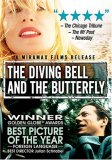| Reviews & Columns |
|
Reviews DVD TV on DVD Blu-ray 4K UHD International DVDs In Theaters Reviews by Studio Video Games Features Collector Series DVDs Easter Egg Database Interviews DVD Talk Radio Feature Articles Columns Anime Talk DVD Savant Horror DVDs The M.O.D. Squad Art House HD Talk Silent DVD
|
DVD Talk Forum |
|
|
| Resources |
|
DVD Price Search Customer Service #'s RCE Info Links |
|
Columns
|
|
|
Diving Bell and the Butterfly, The
THE MOVIE:
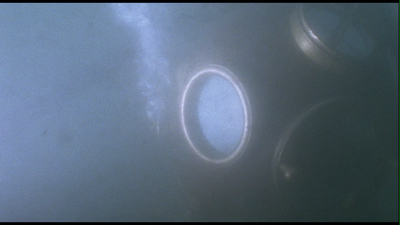
As far as I am concerned, when it came time to hand out awards for the films of 2007, there was no other choice for best director and screenwriter than Julian Schnabel and Ronald Harwood for The Diving Bell and the Butterfly. Their adaptation of Jean-Dominque Bauby's memoir is a masterful synthesis of film language, experience, and literary technique. Bauby's book wasn't really a linear autobiography, but more a collection of memories, flights of fancy, and journalistic descriptions. On the page, it's wonderful, taking the reader in and out of his world in short, evocative chunks. I doubt many people read the slim bio and thought it would be ideally suited to be adapted to a motion picture. The fact that Schnabel and Harwood managed to find a suitable approach to make a compelling movie without sacrificing the specialness of Bauby's writing is an unparalleled cinematic feat.
Jean-Dominique Bauby (played in the film by Mathieu Amalric) was the successful, freewheeling editor of French Elle when he suffered a debilitating stroke in 1995. He was 43 years old. As a result of the stroke, he suffered from "locked-in syndrome," which is exactly what it sounds like. His mind was still active, retaining all of his knowledge and memories, but he was trapped inside a body that was paralyzed from head to toe. At the time of his injury, he could only move his left eye. With the help of his speech therapist (Marie-Josée Croze), Bauby learned to communicate using a version of the alphabet restructured in the order of most common use. Friends and family would recite this alphabet, and Bauby would blink when they hit the right letter. Get a few letters, you have a word; get a few words, and you have a sentence.
It was in this manner that Bauby wrote The Diving Bell and the Butterfly. Working with a dedicated assistant (Anne Consigny), he dictated the manuscript one letter at a time, describing what it felt like to be locked in and sharing the daydreams that provided him his one escape.
Doesn't really sound like the raw material for a movie, does it? Oh, but what a movie it became!
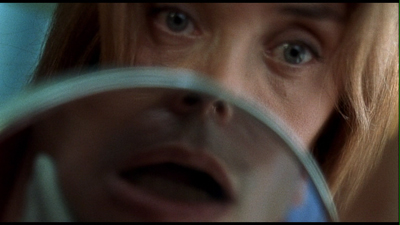
Ronald Harwood, who also wrote The Pianist, takes the basic idea of the book and expands it to include everything that made up the man and his tragic experience. So, not only do we see recreations of the stories from the memoir, but they are padded out with more biographical information and more about the hospital. For instance, a short mention in the book about how the last time Bauby saw his father (Max Von Sydow) he shaved the old man's whiskers becomes an extended scene in the movie. Any small thread in the prose is material Harwood can use to create an entire wardrobe.
Julian Schnabel earned his reputation as a painter before he made the acclaimed films Basquiat and Before Night Falls, and his well-developed instinct for what visual information can be contained within a frame makes him perfect for The Diving Bell and the Butterfly. Much of the movie is shot from Bauby's point of view, and since he had only one eye and limited movement, this means what he sees is often cramped into position and cut off like a bad photograph. Schnabel, working with cinematographer Janusz Kaminski (Spielberg's regular D.P.), also alters the focus within the frame to replicate the ailing man's skewed vision. Even when we aren't looking through Bauby's eye, Schnabel and Kaminski often choose to maintain the feeling of an individual point of view instead of more traditionally composed shots, as if the camera was a person in the background watching. The only time the frame really opens up is when Bauby is fantasizing about being free.
The title The Diving Bell and the Butterfly refers to Bauby's central metaphor for his situation. He feels like he is trapped underwater, unable to move or to escape. Schnabel shows this in several shots of Amalric adrift beneath the ocean, though he chooses to put him in an old-fashioned diving suit rather than the bell, which is more like a craft than it is an individual device. It is not the only visual metaphor that Schnabel creates for the breakdown of Bauby's body and the mental claustrophobia that overtakes him. He also shows documentary footage of crumbling glaciers and more painterly images, like the wheelchair-bound Bauby sitting alone on a platform as the tide overtakes everything around him.
Likewise, Schnabel uses real footage of insects to represent the butterfly side of the story, the part of Bauby that yearns to break free of his paralytic cocoon and live unbounded once again, the special person he can be in his imaginary flights from the hospital. In the filmmakers' hands, the butterfly is also the man that Bauby becomes to his family, the people who are taking care of him, and all of the people the world over whom he has shared his story with. Rather than just lie in bed and let the time tick away, Bauby found multiple ways not to be locked in, to connect with the world and keep his voice alive even when he couldn't talk. Schnabel and Harwood need not explain this, nor do they resort to sanitizing Bauby or deifying him; they never have to stop the film to tell us what a tremendous accomplishment this was or how well it speaks of the tenacity of the human spirit. Just the fact that the story exists at all is testament enough.
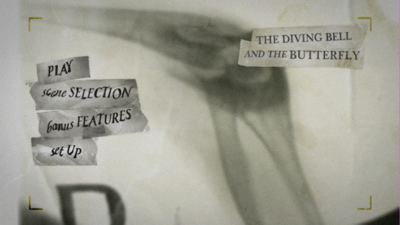
THE DVD
Video:
The 1.85:1 anamorphic transfer of the movie could not be any better. Julian Schnabel uses a variety of color schemes and film stocks to achieve the many different aspects of Jean-Dominique's story he wishes to convey, and the DVD authoring keeps a close eye on the subtleties and the lushness of the cinematography.
Sound:
The DVD for The Diving Bell and the Butterfly is especially tricked out in the audio department. The original soundtrack for the movie was in French, and that track is available on the disc in a 5.1 mix, alongside 5.1 English and Spanish dubs. The soundtrack is as meticulously designed as the visual style of the movie, and the rich remix here keeps every nuance intact.
All three languages have subtitles, as well as a Closed Captioned English version. You may also choose to turn all the subtitles completely off. Though not listed on the menu, the director's commentary is also subtitled in these languages, and they can be accessed via the subtitle button on your remote.
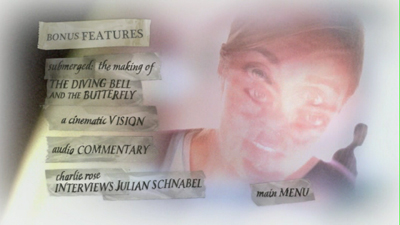
Extras:
"Submerged: The Making of The Diving Bell and the Butterfly" is a serious-minded promo that tackles a lot of the questions you are likely to have: how did the adaptation develop, why shoot in French, why shoot at the actual hospital, the actors' processes, etc. A lot of the focus is on Schnabel, on his approach and the personal investment he had in the project. The featurette packs a lot into 12 minutes, 40 seconds.
The second featurette created especially for this DVD is "A Cinematic Vision," and could have just as easily been folded into the longer piece. Running at just over 7 minutes, it examines how they used the camera to take us inside Bauby's mind and how Janusz Kaminski and Julian Schnabel captured the imagery they wanted while also keeping the actors and the audience comfortable with their relationship with the first-person technique. It also shines a light on the role of editor Juliette Welfling (The Science of Sleep).
Julian Schnabel has recorded an audio commentary to go with The Diving Bell and the Butterfly.The director is not a very animated speaker, nor does he provide a steady stream of chatter, but the commentary is interesting nonetheless. His main interest seems to be in discussing the details that pack the film, including participants who really knew Bauby, the artistic methods used to capture what he was going for, and anecdotes about his team.
Schnabel is a better raconteur, as it turns out, when he has someone to talk to, and the segment from when the director was on Charlie Rose's interview-based television show is quite good. Those who want the trailer for the movie to be on the DVD should also note that the trailer for The Diving Bell and the Butterfly is played almost immediately at the start of this program. (A Truth.com commercial and trailer for Prince Caspian also plays while the disc loads.)
The disc comes in a standard plastic case with a cardboard slipcover. It has an insert sheet with the chapter listing and extra features for the movie on one side, an ad for Becoming Jane on the other.
FINAL THOUGHTS:
Highly Recommended. There is no other movie quite like The Diving Bell and the Butterfly. Julian Schnabel's adaptation of Jean-Dominique Bauby's unusual memoir is an astounding transference of style and tone from page to screen. The true story about a man completely paralyzed and confined to bed, it shows the audience the experience from the main character's point of view, as he learns to communicate without speech and find his way beyond the physical bounds of his broken body. Transcending life and death, it's a hopeful tribute to the human condition. Everyone should see it, should spend a little time with the excellent extras on the disc, and then go out and read the book, too.
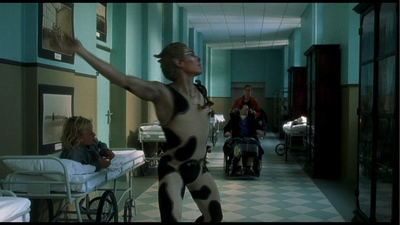
Jamie S. Rich is a novelist and comic book writer. He is best known for his collaborations with Joelle Jones, including the hardboiled crime comic book You Have Killed Me, the challenging romance 12 Reasons Why I Love Her, and the 2007 prose novel Have You Seen the Horizon Lately?, for which Jones did the cover. All three were published by Oni Press. His most recent projects include the futuristic romance A Boy and a Girl with Natalie Nourigat; Archer Coe and the Thousand Natural Shocks, a loopy crime tale drawn by Dan Christensen; and the horror miniseries Madame Frankenstein, a collaboration with Megan Levens. Follow Rich's blog at Confessions123.com.
|
| Popular Reviews |
| Sponsored Links |
|
|
| Sponsored Links |
|
|
| Release List | Reviews | Shop | Newsletter | Forum | DVD Giveaways | Blu-Ray | Advertise |
|
Copyright 2024 DVDTalk.com All Rights Reserved. Legal Info, Privacy Policy, Terms of Use,
Manage Preferences,
Your Privacy Choices | |||||||









